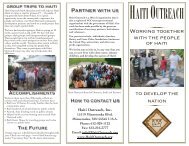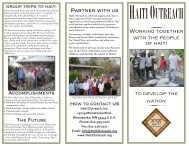hai5249 annual report.rd4 - Haiti Outreach
hai5249 annual report.rd4 - Haiti Outreach
hai5249 annual report.rd4 - Haiti Outreach
You also want an ePaper? Increase the reach of your titles
YUMPU automatically turns print PDFs into web optimized ePapers that Google loves.
<strong>Haiti</strong> <strong>Outreach</strong> projects IN 2004<br />
COMPLETED WORK:<br />
1 Pignon – Five wells completed.<br />
Three homes built by joint <strong>Haiti</strong>an/American groups; repairs to<br />
National School; work on road starting at Pignon towards Hinche;<br />
constructed office/shop/headquarters building for our operations<br />
and to teach post-secondary students (see article on page 4).<br />
<strong>Haiti</strong> Safe Water Plus Project – Fourteen wells in collaboration with<br />
World Vision and Minnesota Rotary Districts #5950 & #5960 (see article<br />
on page 3).<br />
2 Bouloum<br />
8 Palgata<br />
3 Kaliforne<br />
9 Palmiste Ba<br />
4 Kanpech<br />
10 Rode #1 and #2<br />
5 Kawobit<br />
11 Savan Plat<br />
16<br />
6 Labi #1 and #2 12 Savan Paul<br />
7 Nan Croix 13 Savan Sucre<br />
ongoing work with communities:<br />
14<br />
15<br />
16<br />
17<br />
18<br />
19<br />
Bohoc – water system repaired<br />
Boukan Carre – water system completed; continuous observation<br />
Gonaives – flood relief (see article on page 3)<br />
Hinche – Road project with World Vision, starting in Hinche<br />
and going toward Pignon.<br />
La Jeune – Continued school scholarship program at Fwa<br />
Kretyen Ecole for 130 students.<br />
Savanette – Four spring caps built so far, for a water system<br />
that will serve 2,000 people.<br />
In Planning Stages with Communities:<br />
16<br />
20<br />
21<br />
22<br />
1<br />
1<br />
Gonaives – Repairing city water system and irrigation wells.<br />
LaGonave – Digging many wells over entire island affecting<br />
more than 40,000 people.<br />
Mombin Crochu – Building water system to serve 2,000 people.<br />
Nan Bay – Two spring caps built so far, for a water system that<br />
will serve 2,000 people.<br />
Pignon – Building additional classrooms on to the national<br />
secondary school for 400 more students.<br />
Pignon – Establishing Fonkoze microlending bank.<br />
previously Completed:<br />
23 Bassin Zim<br />
28 Platon Chen<br />
24<br />
17<br />
25<br />
26<br />
27<br />
1<br />
Dondon (Matador)<br />
Hinche<br />
La Bruyere<br />
Las Cahobas<br />
Marmelade<br />
Pignon<br />
Area of Detail<br />
29<br />
30<br />
31<br />
32<br />
33<br />
Rankit<br />
St. Raphael<br />
Thomonde<br />
Wozo<br />
Zeb Ginnen<br />
Map No. 3855 Rev. 1 UNITED NATIONS, October 1995 (Colour) Department of Public Information, Cartography Section<br />
27<br />
28<br />
33<br />
24<br />
25<br />
15<br />
22<br />
30<br />
1<br />
19<br />
14<br />
32<br />
4<br />
3<br />
6<br />
29<br />
18<br />
8<br />
23<br />
10<br />
17<br />
20<br />
11<br />
21<br />
5<br />
2<br />
31<br />
12<br />
13<br />
26<br />
9<br />
7<br />
Every <strong>Haiti</strong> <strong>Outreach</strong> project strives to further our mission:<br />
To empower the people of <strong>Haiti</strong> so they’re able to improve their quality of life, strengthen their families and<br />
become self-sufficient.<br />
Dear Friends,<br />
The year 2004 was extremely difficult for <strong>Haiti</strong>. As you know, President Aristide was overthrown and the government<br />
remains unstable. There were two major floods, one in southeast <strong>Haiti</strong> and the more deadly one in and around<br />
Gonaives, the third-largest city.<br />
In the midst of this, the work of <strong>Haiti</strong> <strong>Outreach</strong> continued and expanded in 2004. Here are the highlights:<br />
• The first year partnering with World Vision and the Minnesota Rotary on the <strong>Haiti</strong> Safe Water Plus Project yielded<br />
14 successful community wells in rural areas where no potable water previously existed (see article on page 3).<br />
• Our water truck for well-digging was diverted to hauling daily water rations to tens of thousands of people in the<br />
flood-stricken area of Gonaives. Country Director Neil Van Dine coordinated efforts by various NGOs (nongovernmental<br />
organizations) to bring Gonaives’ water system back online (see article on page 3).<br />
• We built an office/shop/headquarters building to improve coordination and efficiency (see article on page 4).<br />
• The community of Boukan Carre completed its water system.<br />
• Repair began on the incredibly poor road between Hinche and Pignon.<br />
• Scholarships at the Fwa Kretien Ecole in La Jeune continued to support 130 students for the second year, as parents<br />
performed community service.<br />
In 2005, we will increase collaboration with other NGOs in community development work. This includes the<br />
continuation of the <strong>Haiti</strong> Safe Water Plus Project, repair work on the road between Hinche and Pignon, additional<br />
work with water systems in Gonaives, and possibly bringing clean and available water to one of the driest and most<br />
desolate areas of <strong>Haiti</strong>, the island of La Gonave. We also intend to bring the <strong>Haiti</strong>an microlending bank, Fonkoze, to<br />
the Pignon area.<br />
I cannot say enough to thank all of you who share the vision and mission of <strong>Haiti</strong> <strong>Outreach</strong>, and have donated so<br />
generously to make this work possible. Because of you, much has been accomplished, including clean drinking water<br />
for over 70,000 people in <strong>Haiti</strong>. I invite all of you to join us so that this amazing work can continue. All donations are<br />
tax deductible and will enable us to continue partnering with the <strong>Haiti</strong>an people as they work to improve their lives.<br />
Dale Snyder<br />
Executive Director<br />
<strong>Haiti</strong> outreach SUSTAINABLE community development model<br />
1. The request for assistance comes from the people. We do not go into a community and tell them what they need.<br />
2. A diversified representation of the people are involved. The purpose is to have people see themselves as a whole<br />
community, not just one family or church or other faction, and to work together toward a shared goal with benefits for<br />
everyone.<br />
3. The people do the organizing, the planning and all the work they have the manpower and resources to do. We are<br />
willing to offer advice and consultation to facilitate this process.<br />
4. The people create an economically viable maintenance program so that the project will be sustained over time.






